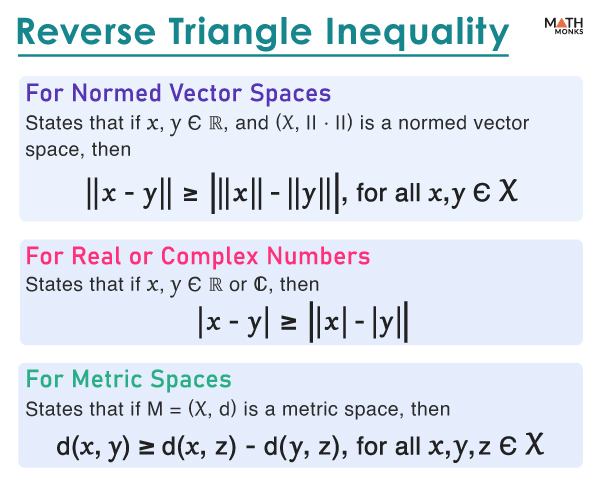Reverse triangle inequality states that the length of each side of a triangle is greater than the difference of the lengths of the other two sides.
Mathematically, it can be expressed as shown:
For Norms
If x and y are real numbers, and (X, || ⋅ ||) is a normed vector space, then ||x – y|| ≥ | ||x|| – ||y|| |, for all x, y Є X.
Proof
|x| = |(x – y) + y| and |y| = |(y – x) + x|
Taking norms and applying the triangle inequality for vectors, we have
||x|| = ||(x – y) + y|| ≤ ||x – y|| + ||y|| and ||y|| = ||(y – x) + x|| ≤ ||y – x|| + ||x||
By rearranging, we get
||x|| – ||y|| ≤ ||x – y|| and ||y|| – ||x|| ≤ ||y – x||
Combining the above two, we get the reverse triangle inequality | ||x|| – ||y|| | ≤ ||x – y||
For Real and Complex Fields
It states that if x and y are either real (ℝ) or complex numbers (ℂ), then |x – y| ≥ | |x| – |y| |, where |x| represents the absolute value of a real or complex number.
For Metric Spaces
If M = (X, d) is a metric space, then d(x, y) ≥ |d(x, z) – d(y, z)|, for all x, y, z Є X.
Proof
Let us consider a metric space M = (X, d)
By the triangle’s inequality, we have
d(x, y) + d(y, z) ≥ d(x, z), for all x, y, z Є X
On subtracting d(y, z) from both sides, we get
d(x, y) + d(y, z) – d(y, z) ≥ d(x, z) – d(y, z)
⇒ d(x, y) ≥ d(x, z) – d(y, z) …..(i)
Now, considering the following cases, we get
Case 1. Assuming d(x, z) – d(y, z) ≥ 0, we have
d(x, z) – d(y, z) = |d(x, z) – d(y, z)| …..(ii)
Now, by using (ii) in (i), we get
d(x, y) ≥ |d(x, z) – d(y, z)|
Case 2. Assuming d(x, z) – d(y, z) < 0, we have
d(y, x) + d(x, z) ≥ d(y, z) (by the triangle’s inequality)
⇒ d(x, y) ≥ d(y, z) – d(x, z)
Since d(x, z) – d(y, z) < 0, which implies d(y, z) – d(x, z) > 0
Thus, d(x, y) ≥ d(y, z) – d(x, z)
⇒ d(x, y) ≥ |d(x, z) – d(y, z)| …..(iii)
From (ii) and (iii), we get
d(x, y) ≥ |d(x, z) – d(y, z)|, for all x, y, z Є X.
Hence, the reverse triangle inequality is proved.

